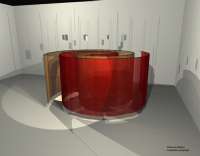Technical aspects
This is an installation made out of suspended fabric panels going from the floor, to 7 feet high at the entrance and finishing off at 9 feet high at the center of the maze. The panels are attached to plastic tubing that is suspended via microfilament from the ceiling using eye-hooks.
I have planned for the entire diameter to be 17.5 feet, though the piece is mutable, and could be made smaller or larger to accommodate space available.
Two different shades of red silk georgette are planned. The fabric is meant to shimmy and flutter as a person or people walk through the maze. Lighting should be positioned above the installation and focused toward the center of the piece.
Shadowy figures will be seen shifting through the piece, with glimpses of the person’s body and clothing through the holes cut in the sides. Empty, the filmy layered colored pieces will be visible from both without and within.
Artist’s Statement
As we explore and invade space and resources, a cross-contamination occurs between what was there and what has entered the area. The most basic idea of an installation is the transformation, or corruption of a space. Humankind lives in a strongly cosmo-centric world. We are part of a much larger Universal system connected to each other through a very complex cultural, symbolic and ecological unit. Though we share a multitude of religions and cultures, art can be considered religion for all, and is often a social bridge in a contemporary sense.
This piece utilizes walking the maze, a concept that surfaced in Christian Renaissance Churches in lieu of traditional medieval pilgrimages. These walks are meant to help the believer see the un-viewable and assist in elevating the mundane human existence to the sublime.
The patterns cut in the sides of the work mimic the pattern of a flock of birds as they fly across the sky or a school of fish swimming as one. Repetition of similar objects or beings can also invoke the idea of a colony forming with a sense of purpose. The simplistic individuality of each piece blurs and becomes submerged in the power of the complex and collective whole. The strength of the group is invoked.
The title gives the viewer a point of entry into the work and grounds it in Buddhist beliefs instead of Christian ones. Buddhism is based on the belief that we are all Buddha beings. All things are Buddha beings. All people have Buddha within. So, an image of the Buddha is not a graven image to be understood concretely. It is something to be seen through. Look through the Buddha and see yourself. Mythical beings or icons that are reduced to everyday objects and people allude to the duality of the accessible sacred. It is through the physical that we learn to live in the spirit. A search without becomes a search within. And the quest becomes to see that which has no form and is unviewable.
Technical aspects
This is an installation made out of suspended fabric panels going from the floor, to 7 feet high at the entrance and finishing off at 9 feet high at the center of the maze. The panels are attached to plastic tubing that is suspended via microfilament from the ceiling using eye-hooks.
I have planned for the entire diameter to be 17.5 feet, though the piece is mutable, and could be made smaller or larger to accommodate space available.
Two different shades of red silk georgette are planned. The fabric is meant to shimmy and flutter as a person or people walk through the maze. Lighting should be positioned above the installation and focused toward the center of the piece.
Shadowy figures will be seen shifting through the piece, with glimpses of the person’s body and clothing through the holes cut in the sides. Empty, the filmy layered colored pieces will be visible from both without and within.
Artist’s Statement
As we explore and invade space and resources, a cross-contamination occurs between what was there and what has entered the area. The most basic idea of an installation is the transformation, or corruption of a space. Humankind lives in a strongly cosmo-centric world. We are part of a much larger Universal system connected to each other through a very complex cultural, symbolic and ecological unit. Though we share a multitude of religions and cultures, art can be considered religion for all, and is often a social bridge in a contemporary sense.
This piece utilizes walking the maze, a concept that surfaced in Christian Renaissance Churches in lieu of traditional medieval pilgrimages. These walks are meant to help the believer see the un-viewable and assist in elevating the mundane human existence to the sublime.
The patterns cut in the sides of the work mimic the pattern of a flock of birds as they fly across the sky or a school of fish swimming as one. Repetition of similar objects or beings can also invoke the idea of a colony forming with a sense of purpose. The simplistic individuality of each piece blurs and becomes submerged in the power of the complex and collective whole. The strength of the group is invoked.
The title gives the viewer a point of entry into the work and grounds it in Buddhist beliefs instead of Christian ones. Buddhism is based on the belief that we are all Buddha beings. All things are Buddha beings. All people have Buddha within. So, an image of the Buddha is not a graven image to be understood concretely. It is something to be seen through. Look through the Buddha and see yourself. Mythical beings or icons that are reduced to everyday objects and people allude to the duality of the accessible sacred. It is through the physical that we learn to live in the spirit. A search without becomes a search within. And the quest becomes to see that which has no form and is unviewable.
